We suggest you have a walk along the famous Via Francigena, which runs through the town centre and touches small villages in the countryside. The landscape is enchanting with tobacco mills, old boroughs, amazing Medici villas and ancient churches.
If you are interested in ancient history, you can visit San Genesio’s Archaeological Site. The site was considered one of the main stops along the Via Francigena, which was the pilgrimage route from Canterbury to Rome in the Middle Ages. The borough of San Genesio was chosen by Popes, Emperors and Bishops to host councils in ancient times and Bishop Sigeric stayed there during his journey back to Canterbury.
During the Middle Ages, the Via Francigena was an important pilgrimage route, not a single road, although it included several possible routes that changed over the centuries. “All roads leads to Rome, you know!”
The Via Francigena, unlike ancient Roman roads, connected abbeys, linking the sacred places of the Christian world. This road soon became an important route for men and goods, thus contributing to the great rebirth of European commerce. The increasing use of the Via Francigena as a trade route led to the development of many towns along the road. The route became the main route to take goods from the east (silk, spices…) to the markets of northern Europe and trade them for cloth from Flanders and Brabant to the Champagne fairs.
In the 13th century the growing importance of Florence and the Arno Valley area marked the end of this ancient route. Nowadays the official route is divided into 80 stages and begins in Canterbury, continues in France, Switzerland and Italy and finishes in Rome. It is 2,000 km long and crosses seven Italian regions – Valle d’Aosta, Piedmont, Lombardy, Emilia Romagna, Liguria, Tuscany and Latium – and 140 municipalities, with a total of 44 stages in Italy.
Today the Via Francigena is also a journey through the Italian landscape. This journey makes modern pilgrims really understand the landscape, the past and the present. The journey turns into a gradual immersion in the roots of our culture, in which changes in the landscape, small and great works of art, the people we meet along the road, make us understand the essence of our heritage.
San Miniato is the part of project “San Miniato in the heart of Tuscany Via Francigena”. Low cost “pilgrim” accommodation (religious facilities, hostels, guesthouses…) and “tourist” accommodation (hotels, B&Bs, accommodation in farms,…) are available along the Via Francigena. There are two main hostels in San Miniato :Ostello San Miniato and Ostello San Francesco.



















